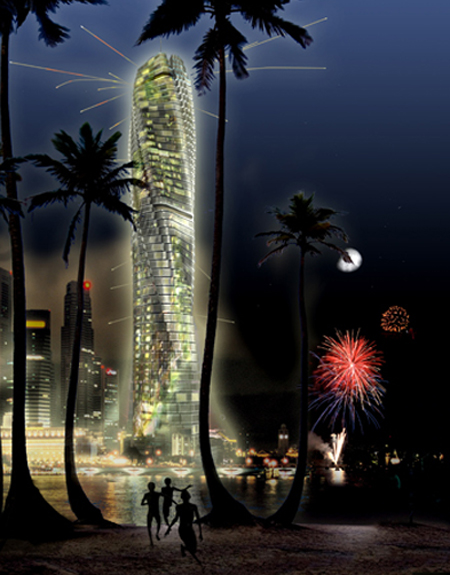
Set to be constructed – of course – in Dubai, this skyscraper designed by architect David Fisher rotates by wind power. But not as a whole – this building rotates by individual floor, creating what Fisher calls ‘dynamic architecture’.
Dynamic Architecture buildings keep modifying their shape. As each floor rotates separately, the form of the building changes constantly; you may not see the same building twice.
Dynamic architecture marks a new era in architecture. This new approach, based on motion dynamics, is in fact a challenge to traditional architecture that until now was based on gravity.
Dynamic Architecture buildings will become the symbol of a new philosophy that will change the look of our cities and the concept of living. From now on, buildings will have a fourth new dimension TIME. Buildings will not be confined to rigid shapes; construction will have a new approach and flexibility. Cities will change faster than we ever imagined. [David Fisher, from dynamicarchitecture.net]
So I know what you’re thinking – incredibly wasteful, right? Not if Fisher is successful in placing horizontal wind turbines between each of the tower’s floors – providing 48 turbines to power the building’s spinning.

In addition to the horizontal turbines, the building is to be fitted with photovoltaic panels on the roof – generating approximately 7 million dollars worth of electricity every year, according to Fisher.
Each turbine can produce 0.3 megawatt of electricity, compared to 1-1.5 megawatt generated by a normal vertical turbine (windmill). Considering that Dubai gets 4,000 wind hours annually, the turbines incorporated into the building can generate 1,200,000 kilowatt-hour of energy.
As average annual power consumption of a family is estimated to be 24,000 kilowatt-hour, each turbine can supply energy for about 50 families. The Dynamic Architecture tower in Dubai will be having 200 apartments and hence four turbines can take care of their energy needs. The surplus clean energy produced by the remaining 44 turbines can light up the neighborhood of the building. [David Fisher, from dynamicarchitecture.net]
So, the building doesn’t just power itself and it’s own spinning/rotating – it can also power its surrounding urban area? My ninja, please…

What’s with people and spinning buildings?
::all images and info from dynamicarchitecture.net::
Wah, tidak terbayangkan sebelumnya.
hay i am vicky soni from india i am very happy to see this buildings . it is very nice. i want to suggetion to you that howmany time will compleate architecture engineering